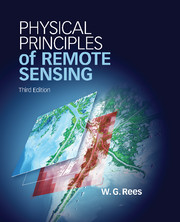Book contents
- Frontmatter
- Contents
- Preface
- Acknowledgements
- 1 Introduction
- 2 Electromagnetic waves in free space
- 3 Interaction of electromagnetic radiation with matter
- 4 Interaction of electromagnetic radiation with the Earth's atmosphere
- 5 Photographic systems
- 6 Electro-optical systems
- 7 Passive microwave systems
- 8 Ranging systems
- 9 Scattering systems
- 10 Platforms for remote sensing
- 11 Data processing
- Appendix Data tables
- References
- Index
- Plate Section
5 - Photographic systems
Published online by Cambridge University Press: 05 December 2012
- Frontmatter
- Contents
- Preface
- Acknowledgements
- 1 Introduction
- 2 Electromagnetic waves in free space
- 3 Interaction of electromagnetic radiation with matter
- 4 Interaction of electromagnetic radiation with the Earth's atmosphere
- 5 Photographic systems
- 6 Electro-optical systems
- 7 Passive microwave systems
- 8 Ranging systems
- 9 Scattering systems
- 10 Platforms for remote sensing
- 11 Data processing
- Appendix Data tables
- References
- Index
- Plate Section
Summary
Aerial photography, as we remarked in Chapter 1, represents the earliest modern form of remote sensing system. Despite the fact that many newer remote sensing techniques have emerged since the first aerial photograph was taken over 100 years ago, aerial photography still finds many important applications, and there are many books that discuss it in more detail than will be possible in this chapter. The interested reader is referred, for example, to Berlin and Avery (2003) and a detailed treatment of photogrammetry and stereogrammetry is give by Kraus (2007). Aerial photography is familiar and well understood, and is a good point from which to begin our discussion of types of imaging system. In particular, it provides a convenient opportunity to introduce some of the imaging concepts that will be useful in discussing some less familiar systems in later chapters.
Photography responds to the visible and near infrared parts of the electromagnetic spectrum. It is, in the context of remote sensing, a passive technique, in that it detects existing radiation (reflected sun- and skylight), and an imaging technique in that it forms a two-dimensional representation of the radiance of the target area. In this chapter we shall consider the construction, function and performance of photographic film, especially its use in obtaining quantitative information about the geometry of objects. Although film-based aerial photography is still dominant, digital photography is beginning (at the time of writing) to rival it, so the chapter includes a brief comparison of the two methods. The chapter then discusses the effects of atmospheric propagation, and concludes by describing the characteristics of some real instruments and giving a brief account of the applications of the technique.
- Type
- Chapter
- Information
- Physical Principles of Remote Sensing , pp. 135 - 163Publisher: Cambridge University PressPrint publication year: 2012



